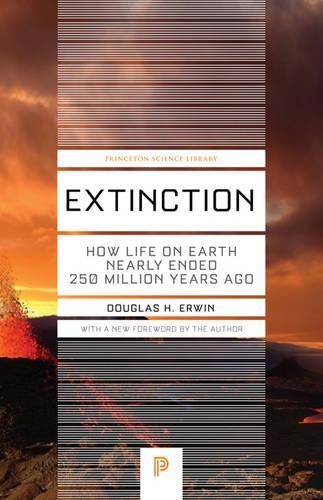
Extinction: How Life on Earth Nearly Ended 250 Million Years Ago - Updated Edition
(Paperback, Updated Edition)
Publishing Details
Extinction: How Life on Earth Nearly Ended 250 Million Years Ago - Updated Edition
By (Author) Douglas H. Erwin
Preface by Douglas H. Erwin
Princeton University Press
Princeton University Press
2nd June 2015
Updated Edition
United States
Classifications
General
Non Fiction
Evolution / Evolutionary biology
Palaeontology
576.84
Short-listed for Choice Magazine Outstanding Reference/Academic Book Award 2006
Physical Properties
Paperback
320
Width 140mm, Height 216mm
255g
Description
Some 250 million years ago, the earth suffered the greatest biological crisis in its history. Around 95 percent of all living species died out--a global catastrophe far greater than the dinosaurs' demise 185 million years later. How this happened remains a mystery. But there are many competing theories. Some blame huge volcanic eruptions that cover
Reviews
One of Choice's Outstanding Academic Titles for 2006 "Theories and mysteries can be dispelled with good data from the geologic record, and Erwin (a paleobiologist at the Smithsonian Institution's National Museum of Natural History) offers an authoritative account of the search for these data and for the cause of the extinction... Extinction provides a great reference for researchers and the interested lay reader alike."--Andrew M. Bush, Science "Extinction is a very enjoyable read... It provides a thoroughly up-to-date account of the causes of the end-Permian event and the developments in the field since 1993 as seen through the eyes of one of the key players... Extinction leaves the reader with the (accurate) picture that here is a scientist whose work has significantly advanced our understanding of the greatest extinction event known to science... [A] readable and scholarly account."--Richard J. Twitchett, American Scientist "Douglas Erwin's geological mystery story is engrossing. It contains a tribute to the scientific method--and also the collaborations of research. The book ends with Erwin warning that the Earth is arguably entering another mass extinction period, this time unnatural and man-made. And this time the destruction may well be total."--Lucy Sussex, The Age (Sunday edition) "Douglas H. Erwin, a Smithsonian paleobiologist and one of the leading experts on the Permian extinction has meticulously sifted through the evidence... His accessible new book, Extinction--written, it seems, both to persuade his colleagues and to educate a lay audience--is told from the perspective of a forensic scientist trying to piece together a quarter-billion-year-old crime scene."--Joshua Foer, Washington Post Book World "Douglas Erwin describes how life on Earth was nearly destroyed at the end of the Permian period, 250 million years ago... The author ... explain[s] what this paleontological, as well as geological, evidence can tell scientists about the dramatic and deadly shift in the Earth's environment."--Science News "No one can tell this story better than Douglas Erwin. His book is a superbly written account of what we know about the Permian extinctions... More than a geological story, this book is an excellent model of how science addresses complicated questions."--Choice "This book does not justify a single, accepted causal sequence of events ... to account for the end-Permian extinction. Instead, Erwin dissects the evidence for and against each hypothesis, impartially weighing their strengths and weaknesses. Although this book may frustrate readers expecting to learn how life nearly ended 250 million years ago, it will reward them with a fascinating case study in scientific inference, a case that remains very much open."--John P. Hunter, Quarterly Review of Biology "Erwin's book is science writing for the general public at its best and most lucid. Entertaining, informative, and thought provoking."--Northeastern Naturalist "Erwin offers a thorough overview of one of the most interesting problems in earth history... Erwin takes the readers on an insider's journey that includes adventures in the field, tedious hours in the laboratory, and stimulating but sometimes contentious exchanges among colleagues at scientific meetings. He gives rigorous consideration to every reasonable hypothesis... Erwin's short course is a professional service for geologists (like me) who have read only some of the primary literature on the end-Permian extinction."--Stephen O. Moshier, Books & Culture "For scientists as well as general educated readers, this book enlightens its readers to the complexity of the largest biological crisis the earth has yet seen."--H.J.M. Meijer, PalArch's Journal of Vertebrate Paleontology "I recommend Extinction: How Life on Earth Nearly Ended 250 Million Years Ago to scientists and nonscientists alike. It provides a clear, comprehensive, and compelling introduction to the greatest catastrophe in the history of animal life and proposes a reasonable hypothesis for the cause of the extinction that will undoubtedly be tested vigorously with new data in the coming decade."--Jonathan L. Payne, Complexity
Author Bio
Douglas H. Erwin is senior scientist and curator in the Department of Paleobiology at the Smithsonian's National Museum of Natural History. He began researching the end-Permian mass extinction in the early 1980s and has traveled many times to China, South Africa, and Europe seeking its causes.
